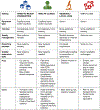Rapid diagnostic tests to address challenges for global measles surveillance
- PMID: 32615510
- PMCID: PMC7492366
- DOI: 10.1016/j.coviro.2020.05.007
Rapid diagnostic tests to address challenges for global measles surveillance
Abstract
Recently, a lateral flow rapid diagnostic test (RDT) with good accuracy has been described. This test enables measles specific IgM antibody detection in serum, capillary blood and oral fluid. RDTs have the potential to transform measles surveillance by allowing real-time case confirmation outside of central/regional laboratories and by facilitating a timely public health response. Measles virus genes can also be amplified and sequenced consistently from dried IgM-positive RDTs stored outside of cold chain, which will enable more complete virologic surveillance. Critical questions remain regarding operational use of RDTs as part of global measles surveillance. Projects to evaluate RDT use as part of national surveillance programs and to commercialize the RDT are underway.
Copyright © 2020 Elsevier B.V. All rights reserved.
Conflict of interest statement
Conflict of interest statement
Nothing declared.
Figures


Similar articles
-
A measles IgM rapid diagnostic test to address challenges with national measles surveillance and response in Malaysia.PLoS One. 2024 Mar 14;19(3):e0298730. doi: 10.1371/journal.pone.0298730. eCollection 2024. PLoS One. 2024. PMID: 38483868 Free PMC article.
-
Evaluation of a rapid diagnostic test for measles IgM detection; accuracy and the reliability of visual reading using sera from the measles surveillance programme in Brazil, 2015.Epidemiol Infect. 2023 Aug 4;151:e151. doi: 10.1017/S0950268823000845. Epidemiol Infect. 2023. PMID: 37539522 Free PMC article.
-
Improving molecular tools for global surveillance of measles virus.J Clin Virol. 2013 Sep;58(1):176-82. doi: 10.1016/j.jcv.2013.05.018. Epub 2013 Jun 24. J Clin Virol. 2013. PMID: 23806666 Free PMC article.
-
Molecular epidemiology of measles virus.Curr Top Microbiol Immunol. 2009;330:129-50. doi: 10.1007/978-3-540-70617-5_7. Curr Top Microbiol Immunol. 2009. PMID: 19203108 Review.
-
The challenges and strategies for laboratory diagnosis of measles in an international setting.J Infect Dis. 2003 May 15;187 Suppl 1:S283-90. doi: 10.1086/368040. J Infect Dis. 2003. PMID: 12721927 Review.
Cited by
-
Experiences of sharing results of community based serosurvey with participants in a district of Maharashtra, India.PLoS One. 2022 Aug 4;17(8):e0271920. doi: 10.1371/journal.pone.0271920. eCollection 2022. PLoS One. 2022. PMID: 35925959 Free PMC article.
-
Modeling the Transmission Mitigation Impact of Testing for Infectious Diseases.medRxiv [Preprint]. 2024 Mar 5:2023.09.22.23295983. doi: 10.1101/2023.09.22.23295983. medRxiv. 2024. Update in: Sci Adv. 2024 Jun 14;10(24):eadk5108. doi: 10.1126/sciadv.adk5108. PMID: 37808825 Free PMC article. Updated. Preprint.
-
Modeling the transmission mitigation impact of testing for infectious diseases.Sci Adv. 2024 Jun 14;10(24):eadk5108. doi: 10.1126/sciadv.adk5108. Epub 2024 Jun 14. Sci Adv. 2024. PMID: 38875334 Free PMC article.
-
Vaccination strategies for measles control and elimination: time to strengthen local initiatives.BMC Med. 2021 Jan 5;19(1):2. doi: 10.1186/s12916-020-01843-z. BMC Med. 2021. PMID: 33397366 Free PMC article.
-
Possible Paths to Measles Eradication: Conceptual Frameworks, Strategies, and Tactics.Vaccines (Basel). 2024 Jul 22;12(7):814. doi: 10.3390/vaccines12070814. Vaccines (Basel). 2024. PMID: 39066451 Free PMC article. Review.
References
-
- World Health Organization: Measles vaccines: WHO position paper - April 2017. Wkly Epidemiol Rec 2017, 92:205–227. - PubMed
-
- Patel MK, Dumolard L, Nedelec Y, Sodha SV, Steulet C, Gacic-Dobo M, Kretsinger K, McFarland J, Rota PA, Goodson JL: Progress toward regional measles elimination - worldwide, 2000–2018. MMWR Morb Mortal Wkly Rep 2019, 68:1105–1111 - PMC - PubMed
-
In this most recent of an annual series, the authors summarize progress towards global measles elimination by WHO region in terms of routine immunization coverage, campaign coverage, reported incidence and estimated measles mortality. The article highlights the remaining gaps in immunization programs and surveillance in order to achieve regional measles elimination goals.
-
- Durrheim DN, Crowcroft NS, Blumberg LH: Is the global measles resurgence a “public health emergency of international concern”? Int J Infect Dis 2019, 83:95–97. - PubMed
-
- Thornton J: Measles cases in Europe tripled from 2017 to 2018. BMJ 2019, 364:l634. - PubMed
-
- World Health Organization: Vaccine Preventable Diseases Surveillance Standards: Measles chapter. 2018. [https://www.who.int/immunization/monitoring_surveillance/burden/vpd/stan...].
Publication types
MeSH terms
Grants and funding
LinkOut - more resources
Full Text Sources
Medical

